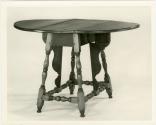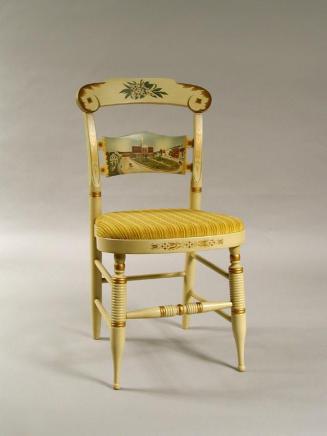Oval Table with Falling Leaves
Original OwnerOriginally owned by
Rufus North
(American, 1769 - 1841)
Original OwnerOriginally owned by
Esther Roberts North
(American, 1768 - 1856)
Furniture MakerMade by
Unknown
Date1750-1790
MediumMaple, pine and cherry, iron hardware
DimensionsPrimary Dimensions (height x width x depth of top when open): 27 3/16 x 42 1/2 x 36 1/4in. (69.1 x 108 x 92.1cm)
ClassificationsFurniture
Credit LineGift of Frederick K. and Margaret R. Barbour
Object number1964.33.8
DescriptionMaple oval table with falling leaves, or butterfly table, in the William and Mary, or early baroque, style. The top is oval, consisting of a stationary center section joined with hinges to a leaf on each side. The frame has four plain rails four stationary legs that support the center section; the legs are raked, or slanted out, from top to bottom. Each leg has a block at the top over turned ring-and-baluster forms, over a block at the ankle, and a turned foot. Each leg is connected at the ankle by a turned stretcher, with a similar turned ring-and-baluster forms, and a block in the middle. Each long side of the frame has a panel of wood with an elaborately shaped edge that pivots to support the leaf when open. The edge is tapered from top to bottom, and is shaped with a quarter circle over a fillet, a large cyma curve, or S-curve, a fillet, a recessed C-curve, a fillet, and a projecting C-curve. The pivoting support rests on the rectangular section in the center of each long side stretcher.
Condition: The center section of the top has some splits and two small holes that have been repaired; the center section of the top also has a recessed area. The edge of one leaf has a small wooden pin is inserted near a split in the wood. The top has been secured with screws through the frame. One pivoting support has splits in the wood that have been repaired. One leaf has a thin layer of wood added to the underside, where the pivoting support rests when open. Each foot is well worn, but original. The butterfly table is refinished; the underside of the top has two layers of an earlier finish, one red and one black.
Design and Construction Details: Each section of the top is constructed of a single board. Each leaf is joined to the stationary center section with two hinges along a rule joint. The top is joined to the frame with four wooden pins and screws through the frame (the screws are a later addition). Each rail on the frame is tenoned and double pinned into the rectangular top of a leg. Each stretcher is tenoned and pinned into the ankle near the bottom of a leg. Each rail on the long side of the frame has a lap joint that accommodates the pivoting support when closed. The pivoting support begins just underneath the top, and has two cut-outs to accommodate the shape of the rail. Each support pivots on round hinge pins that fit into the long side rail and stretcher below.
Condition: The center section of the top has some splits and two small holes that have been repaired; the center section of the top also has a recessed area. The edge of one leaf has a small wooden pin is inserted near a split in the wood. The top has been secured with screws through the frame. One pivoting support has splits in the wood that have been repaired. One leaf has a thin layer of wood added to the underside, where the pivoting support rests when open. Each foot is well worn, but original. The butterfly table is refinished; the underside of the top has two layers of an earlier finish, one red and one black.
Design and Construction Details: Each section of the top is constructed of a single board. Each leaf is joined to the stationary center section with two hinges along a rule joint. The top is joined to the frame with four wooden pins and screws through the frame (the screws are a later addition). Each rail on the frame is tenoned and double pinned into the rectangular top of a leg. Each stretcher is tenoned and pinned into the ankle near the bottom of a leg. Each rail on the long side of the frame has a lap joint that accommodates the pivoting support when closed. The pivoting support begins just underneath the top, and has two cut-outs to accommodate the shape of the rail. Each support pivots on round hinge pins that fit into the long side rail and stretcher below.
Status
Not on view










